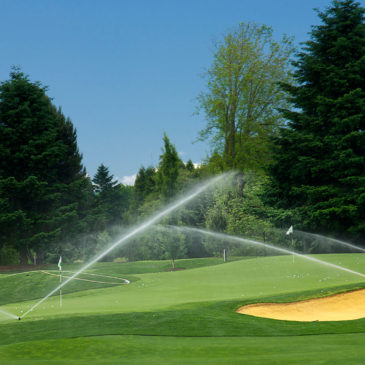This article originally appeared on GolfAdvisor.com
Is There a Future for Golf in Cities?
BY: JOHN THOMPSON
As cities grow in size and expense, golf will need to adapt to remain a part of the urban environment.
As more and more people move into urban areas around the world, land is becoming more precious and skyrocketing in value. An estimated 24.2 million Americans (8 percent) played golf last year according to the National Golf Foundation. That means there are a lot of non-golfing city dwellers who see vast expanses of greenspace as no benefit to them.
In recent years, housing advocates have targeted golf courses as ideal land that would be more beneficial for additional supply. Governments are feeling the pressure as well. In Singapore, for example, two courses have been ordered to turn their land over to the state for housing development when their lease runs out. In the United States, city councils in metros like Seattle and Portland are openly pondering how much of their urban land should be dedicated to golf as residents clamor for more housing supply.
The green, leafy enclaves of a golf course certainly feels like an out-sized luxury for cramped urban quarters.
But science continues to discover ways that golf courses in urban areas can serve as a benefit city residents, even if they never play a single hole.
Science of the Green
Dr. Brian Horgan is one of the leading scholars advocating for the presence of golf courses in urban landscapes. In 2017, he was one of the founders of Science of the Green, a 5-year research partnership between the University of Minnesota and the United States Golf Association (USGA). Their main objective? To help create new innovations in the sport of golf that fell in line with the USGA’s “Road Map to 2025,” which sets the goals of improving golfer satisfaction by 20% while reducing critical resource consumption by 25%.
“Sustainability has been near and dear to my research for more than 20 years,” said Horgan.
More recently, Dr. Horgan presented “The Value of Golf in an Urban Ecosystem: A Natural Capital Project case study” at the USGA’s 5th Golf Innovation Symposium in Tokyo. He educated the audience on some of the most notable environmental challenges in cities and how can golf courses minimize, if not eradicate, these problems.
His findings revealed that golf courses take on many identities, some of which parallel the ails of urban life.
In return, courses automatically gain three payoffs: retaining stormwater, recharging underground aquifers and cooling the general climate around them. Not only is this an environmental benefit, but it is also an economic one. The presence of efficient stormwater retention basins and healthy underground aquifers means less flood damage and greater ability to tap the aquifer underground to use for watering. Keeping overall temperatures stable also has multiple benefits like healthier plant life, more wildlife and better quality of life for humans living in the area.
Audubon Cooperative Sanctuary Program for Golf
Another avenue that golf courses can go down to improve their environmental footprint is with groups like the Audubon Cooperative Sanctuary Program for Golf. The ASCP works with golf courses to protect and enhance the natural areas and wildlife habitats that golf courses provide. Membership provides courses with a site assessment and environmental plan of action to help with practices such as environmental planning, wildlife habitat management, chemical use reduction and safety, water conservation and quality management and outreach and education.
“Our program encourages courses to naturalize the best they can,” said Frank Lavardera, Director of Environmental Programs for Golf at the Audubon.
An individual outside the game of golf might assume that the game still looks the same as it did forty years ago, but people like Laverdera have been quietly working to reduce the environmental footprint of golf. They start with water consumption.
“On average, we see about 40% less water used once we come in and help educate a course on what they can do better,” said Lavardera. “We first ask, are courses benefiting the environment as they exist right now? Then, we look for the closest source of natural water and find out how to maximize the use of that source. That may look like accessing an existing body of water or it may look like recommending an investment in creating an irrigation pond to continually tap and reuse.”
The ASCP also works diligently on tackling the proper maintenance and consumption of pesticide use on courses.
“Since the 1970s, maintenance facilities have changed dramatically. We have introduced dedicated wash pads to clean off any item that has been near or around the chemical solutions that help keep the course groomed. The implementing of bioswales (channels that filter pollution while directing water runoff) has also been huge in naturalizing courses. Not only do they act as clean sources of water retention, but they can also be strategically placed to exist as a water hazard on a hole,” says Laverdera.
While most people can get behind these changes, the obvious elephant in the room is the significant costs needed in renovations.
“Course owners have to look at what we do as an investment,” said Lavadera. “We know that naturalizing a course appeals to younger audiences and gets non-golfers interested. We also know the community around these courses wants to see them succeed. That is why we advise owners to hold open houses regularly to educate and inform the public on what they are doing to improve their courses.”
With the continued work of the ASCP and the Science of the Green, a future where all golf courses coexist with their natural landscapes is not too far off. A solid prediction of when most golf courses will make these changes might be 15 to 20 years down the road. However, we might see them even sooner at courses in urban landscapes.
Much of the focus about the future of golf is aimed at “growing the game” by filling tee sheets with avid new players. But the focus on youth could be as much about participation as it is about cultivating a new generation that appreciates the many benefits of properly-managed golf course acreage. In cities, which are typically full of young, climate-conscious professionals, the perception of a golf course as not just a sporting grounds but a working and critical piece of the urban environment could help garner allies for the sport.
Nate Clemmer, CEO at SynaTek Solutions and Founder of Branch Creek, has been studying soils and turf landscapes and sees an opening for golf as more young people are aware of climate change and have taken an interest in permaculture, regenerative agronomy and farming practices. More research is now being done on soils and there are many reasons to be optimistic that properly managed turf that is less dependent on chemical fertilizer and pesticides can have huge environmental benefits. Clemmer says that because of how many roots are in turf compared to a row of crops, golf courses have the potential to be much more powerful than agricultural land when it comes to carbon sequestering.
“Golf has an outstanding future to not be a problem, but be a part of the solution,” said Clemmer. “Soil, managed properly, has ability to put carbon back where it came from. Golf is one of the places it would actually have a tangible impact on the course of climate.”
“In an urban environment, 50-60 acres might be the most open space that exists in that zip code. We have the potential to sequester more carbon on 60 acres of turf than on 600 acres of agriculture.”
Not every human being living in a city will become an avid golfer, but if golf courses can demonstrate their grounds are efficient and beneficial to all city dwellers and not just the golfers with the time and money to the stroll the fairways, the collective citizen sentiment may sway towards thinking golf courses aren’t a prime place for more condos, but instead a feature of why the 21st century city is a desirable place to be.



